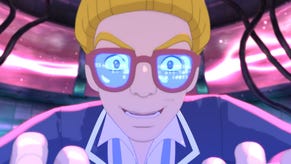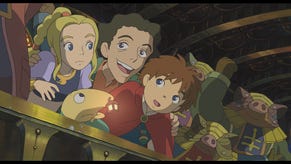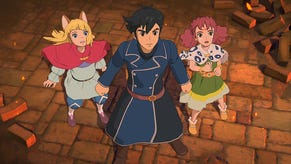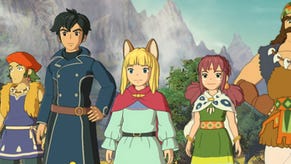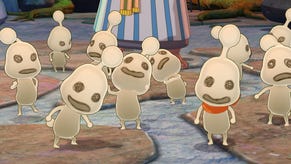Ni No Kuni 2 Review
Ni No Kuni returns with a new storybook RPG. Our full review.
This article first appeared on USgamer, a partner publication of VG247. Some content, such as this article, has been migrated to VG247 for posterity after USgamer's closure - but it has not been edited or further vetted by the VG247 team.
Ni No Kuni 2 has a novel take on politics. In an era of bad faith politicians and screaming pundits, Ni No Kuni offers a story in which things can get done if you simply ask nicely. It takes a strikingly optimistic view on racism and global cooperation in an era of rising nationalism.
In essence it's a fairy tale (with a bit of a twist)—one where good kings and queens are willing to work together to build prosperous societies. It comes across as so sweet and naive that it's almost possible to overlook King Evan Pettiwhisker's subjects slaving away in a mine while he sips tea in his castle.
Ni No Kuni 2 is the follow-up to Ni No Kuni: Wrath of the White Witch, which mixed Pokemon-like creature collecting with Studio Ghibli's distinctive visuals. It more or less retains the look of the previous game, but changes almost everything else. It follows the aforementioned Evan Pettiwhisker in his quest to build a kingdom and unite the world, in which he's joined by Roland, a politician from our own universe.
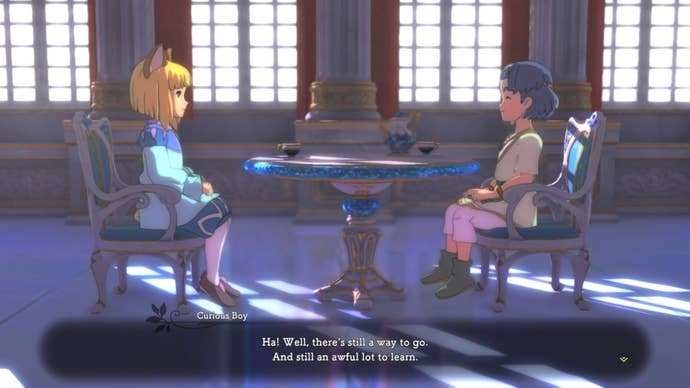
Additional party members join as the story goes on—sky pirates, a pink-haired engineer—but they're mostly incidental outside of the quests where they're introduced. This is Evan and Roland's story. I won't deny it's cute. The richly cel-shaded world of Ni No Kuni is by far its biggest strength, its storybook feel further enhanced by a mix of talking animals and over-the-top humans. It's meant to be a fun, lightweight RPG—a callback to the days of Dragon Quest, which itself is a heroic fairy tale of sorts, that combines elements from our own world. Combined with an excellent soundtrack, Ni No Kuni 2 largely manages to recapture the look and feel of the "good old days" of JRPGs on the PS2.
Kingdom Come
The lightness of Ni No Kuni 2's story carries into the combat, a hack-and-slash affair in which you play as one party member while everyone else is controlled by the CPU. In addition to their normal attacks, every character has a handful of special elemental skills, which are mapped to the face buttons, and these are essential for taking down enemies quickly. If you know what element an enemy is weak to, it's often possible to end battles with just a couple skill attacks.
Ni No Kuni 2 piles on a number of additional systems on top of the core combat to offer a bit more depth, but that's the basic gist of it. You may have seen the marketing for Ni No Kuni 2 playing up the role of the Higgledies—tiny elemental sprites that can launch a handful of strong area attacks, buff your attack and defense, and even power up your special skills. They're useful, but they rarely turn the tide of battle. It's possible to level them up, as well as to craft new ones, but the pool of new Higgledies feels strikingly small owing to the limited number of skills that can be attached to them. I stuck to leveling up my original set of four and did just fine for myself.
In general, your chances in battle are dependent on whether or not you have good gear. Indeed, equipment is so disproportionately important that the right sword makes it possible for a level 40 party to easily face down level 60 monsters. There's a system called the Tactics Tuner that lets you choose whether you want to do more damage to certain types of monsters, but its impact is hardly noticeable during actual combat (its more useful for choosing whether you'd prefer a higher equipment drop rate or XP gain). As with the Higgledies, you can practically ignore the Tactics Tuner and still do just fine for yourself.
One system that is impossible to ignore is the castle. Introduced around Chapter 4, it dominates Ni No Kuni 2's progression, crafting, and story. As with many mobile games, it ticks away automatically in the background, offering plenty of impetus to return often to gather up money, materials, and completed researched. It also offers access to high-quality armor and weapons, as well as opportunities for additional XP growth. Suffice it to say, you'll want to invest in your castle early and often.
The shops that you build are staffed up by completing sidequests and earning the loyalty of new characters, who subsequently move into Evermore and take on a variety of side jobs. Amusingly, those jobs can vary wildly in terms of a character's quality of life. One of the first things I did when I unlocked Evermore was stick Tani in the mines, where she remained for the rest of the game. Assigning characters boosts research time among other perks, and Tani was evidently best-suited for toiling miles beneath the earth. Sorry, Tani.
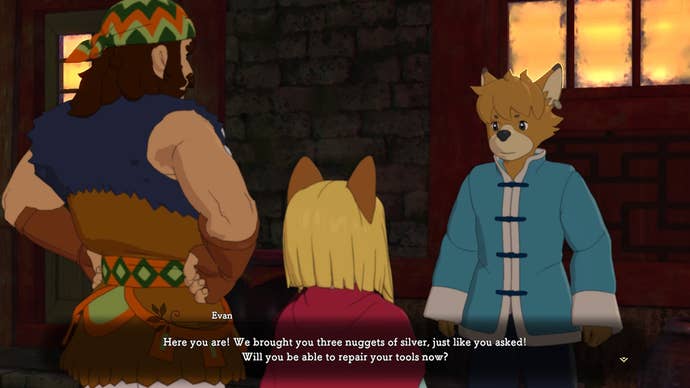
Evermore winds up being Ni No Kuni 2's main hub, with its development progress even gating portions of the main quest, and that's unfortunately where it falls down a bit. That's because you need to individually recruit roughly 50 characters to level up your castle enough to reach the endgame, and that's accomplished almost entirely through fetch quests. The cost of actually leveling up the castle is also quite steep, and just earning the materials needed to move on ends up tacking on an additional 5 to 10 hours to the final playtime.
I'm personally the sort of person who prefers to play RPGs organically, taking on only the sidequests that interest me. I hate fetch quests and as a rule I avoid them unless they can be completed quickly. Ni No Kuni 2 basically makes these quests mandatory, and that's a large strike against it in my eyes. That's too bad because for the most part I really like Evermore. It feels connected to the heart and soul of Ni No Kuni 2, and it's always satisfying to return and find more research, more money, and more items for crafting. Just make sure you remember that you do the sidequests as they come in, or you're going to have a lot of catching up to do when you reach the end of the game.
The Rest of Ni No Kuni 2
Ni No Kuni 2 winds up settling into a comfortable cycle by Chapter 4 or so. You'll find a kingdom in distress, save its monarch, and start harvesting its citizens for Evermore. The dungeons are a simple mix of combat and traversal puzzles where you hit switches to line up platforms or light a set number of torches within a time limit. Each cycle ends with a large and visually impressive setpiece boss for you to defeat. Ni No Kuni 2 never really deviates from this cycle in the main part of the game, and while I some might call it relaxing, I found it a bit monotonous by the third kingdom or so.

Unfortunately, the word that popped into my head a lot as I played was "padding." Ni No Kuni 2 takes around 35 hours to complete, but a lot of that is grinding sidequests and money to build up your kingdom. It's further filled out with what I would call "logistical quests"—missions where you have to collect an item needed to build a boat so you can get to your next destination. All of this padding makes Ni No Kuni 2 feel like a 15 hour RPG that was bloated up to a 35 hour one.
The budget feel of the padding is further accentuated by the strikingly ugly overworld, which represents a rather large step down from the original Ni No Kuni. Its simple look is billed as a stylistic choice, but it clashes harshly with the lovely cel-shading of the main game. The same goes for Ni No Kuni 2's strategy segment, which requires you to lead an "army" of four different unit types against waves of enemies. Like the normal combat, each unit has a special skill, with reinforcement availability being calculated off a finite Might stat. It looks complicated, even featuring its own weapons triangle, but what it boils down to is staying just far enough back for your archers to do their work while mixing in some special skills. It's tedious, and because it takes place on the overworld, it's also quite ugly.

When Ni No Kuni 2 works, it feels like a pleasant throwback to the best days of the PS2. It's very pretty, battles never take very long to complete, and it's fun to watch your tiny kingdom blossom into a full-blown nation state. But there's a lot that drags it down too. The combat is fast and painless, but also fairly shallow. The cel-shading is great, but too much of the action takes place on the simplistic overworld. Building a castle is fun, but it's hard to care about any of the characters outside of Evan and Roland, and progression leans too heavily on fetch quests.
Most frustrating of all is how it all ultimately plays out. There's a kernel of a legitimately great (and frankly very dark) story in Roland's past, but Ni No Kuni 2 seems afraid to follow through on what could have been a tremendous premise. It's too much of a fairy tale for its own good.
I said before that Ni No Kuni 2 is better than I expected, but that's mostly because I expected it to be bad. Instead, it's decent. But I'm not sure it rises to the bar set by recent big-budget RPGs, or even the bar set by its predecessor. In that respect, while I enjoyed Ni No Kuni 2 well enough, I have a hard time seeing it as much more than a second-tier RPG in a world where first-rate Japanese roleplaying games are more common than ever.
ConclusionNi No Kuni 2 is a sweet-tempered and attractive RPG with a strong castle-building mechanic, but it's dragged down by a jarringly ugly overworld, mandatory fetch quests, and a lot of padding. It's a pleasant throwback for fans of the genre, but it ultimately fails to meet the high bar set by other big-budget JRPGs.




